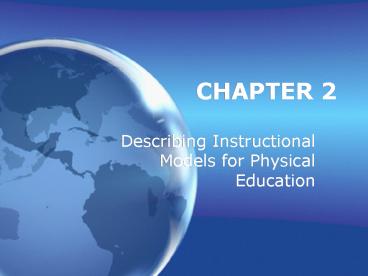Describing Instructional Models for Physical Education PowerPoint PPT Presentation
1 / 20
Title: Describing Instructional Models for Physical Education
1
CHAPTER 2
- Describing Instructional Models for Physical
Education
2
Advantages of Using Model-Based Instruction in PE
- Provides an overall plan and coherent approach to
teaching and learning - Clarifies learning domain priorities and domain
interactions - Provides an instructional theme
- Allows teacher and students to understand current
and upcoming events - Furnishes a unified theoretical framework
- (continued)
3
Advantages of Using Model-Based Instruction
(continued)
- Has research support
- Promotes a technical language for teachers
- Verifies the relationship between instruction and
learning - Allows for more valid assessments
- Encourages teacher decision making
- Promotes specific standards and learning outcomes
4
Framework for Describing the Models
5
Foundations of the Models
- Theory and rationale
- Assumptions about teaching and learning
- Theme
- Learning priorities and interactions
- Student developmental requirements
- Validation
6
Learning Domains
- Each model emphasizes different kinds of learning
outcomes - Outcomes should match the teachers instructional
goals - Models are based on learning domain goals
- Cognitive
- Psychomotor
- Affective
7
Examples of Developmentally Inappropriate and
Appropriate Practices
- Comprehension of information
- Inappropriate Teacher uses words, terms that
students dont know - Appropriate Teacher uses only familiar words and
terms when talking to students - Decision making and responsibility
- Inappropriate Students are expected to pick
fair teams but cannot do so - Appropriate Teacher selects teams before
class - (continued)
8
Developmentally Inappropriate and Appropriate
Practices (continued)
- Social/emotional maturity
- Inappropriate Immature students are placed in
tasks that provide an opportunity to cheat - Appropriate Teacher gives students rules to
follow and monitors students progress - Prerequisite knowledge and ability
- Inappropriate Teacher assumes all students have
experience with the content - Appropriate Teacher conducts a needs assessment
before the unit begins
9
Student Learning Preferences
- Different models use differing teaching
strategies and appeal to different types of
students - Collaborative students
- Competitive students
- Participant students
- Avoidant students
- Independent students
- Dependent students
10
Validation of Models
- Research knowledge
- optimal ways to use a model
- Craft knowledge
- derived from teachers experiences with models
- Intuitive knowledge
- sometimes a model just makes sense
11
Teaching and Learning Features of the Models
- Directness and inclusiveness
- Learning tasks
- Engagement patterns
- Teacher and student roles and responsibilities
- Verification of instructional processes
- Assessment of learning
12
Profile of a Models Directness or Indirectness
13
Learning TasksWhat Will Be Learned and How
- Task presentation
- Task structure
- Content progression
14
Engagement Patterns
- Active or passive
- Individual, small group, or whole class
15
Benchmarks
- Patterns of teacher and student operations that
should happen when using a model - Reminders to teachers of how to teach and how
students will learn in that model - Verification of proper planning and instructional
operations
16
Assessment of Learning
- What standards or learning outcomes will be
assessed? - When will they be assessed?
- What assessment techniques are valid?
- Is the assessment procedure practical?
- Can the outcomes be assessed with authentic
techniques?
17
Implementation Needs and Modifications of the
Models
- Teacher expertise
- Key teaching skills
- Contextual requirements
- Contextual modifications
18
Process for Selecting an Instructional Model
- What do I want my students to learn?
- What are my domain priorities?
- Which models have those same priorities?
- What are the contextual requirements?
- How well does my context meet those requirements?
- (continued)
19
Process for Selecting an Instructional Model
(continued)
- What are the teacher and student prerequisites
for the remaining models? - Do I and my students have enough of those
prerequisites? - What modifications will I need to make for each
model?
20
- Questions?
- Issues and/ or concerns
- Comments!!!

